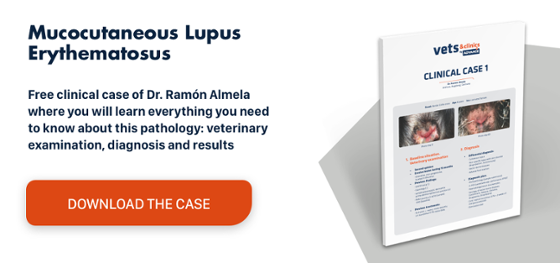Mange in cats: a description of notoedric mange
Which mites are responsible for mange in cats?
There are three types of parasite which most often affect domestic cats:
Notoedres cati: This mite is exclusive to cats and causes notoedric mange, which is also known as feline scabies. Its presentation is pruritic and scaly, besides being highly contagious. The mites initially settle in the animal’s head and ears where they cause severe skin infections; but they can spread to other areas of the body.
Cheyletiella spp.: This type of mite produces cheyletiellosis mange and is commonly known as “mobile/walking dandruff”. It causes severe flaking accompanied by pruritus. It is highly contagious in catteries and among groups with poor hygiene.
Otodectes cynotis: This mite is responsible for otodectic mange, a skin disease that develops when the mite multiples in the external auditory canal. It is accompanied by scales, scabs and dark secretions.
Demodex cati: This is the cause of demodicosis. It is much more common in dogs, but can also occasionally affect cats. In cats it is usually associated with underlying causes of viral or metabolic immunosuppression. There is a type of demodicosis caused by Demodex gatoi that is considered contagious among cats; but it is very rare.
Notoedric mange: aetiology
Notoedres mites are closely related to sarcoptic mange mites in dogs, so the two infections bare some resemblance.
The complete cycle takes approximately 21 days and occurs on the host. The female and male copulate on the surface of the cat’s skin and then the female digs tunnels, creating pruritic papules at the entry points.
Notoedric mange: clinical signs
The characteristic clinical signs include intense pruritus, erythematous papules, seborrhoea, alopecia and pyoderma. It usually begins with scabs and scales in the medial area of the outer ear, before spreading over the face and neck and possibly reach other parts of the body, such as the extremities. That is, it can affect the cat’s entire body. Without treatment, the skin condition can become chronic, leading to hyperkeratosis and hyperpigmentation.
Notoedric mange: diagnosis
Vets can make a definitive diagnosis by performing a complete physical examination, scanning the skin with a Wood’s lamp and taking scrapings from the affected areas (to confirm the mite’s presence under a microscope). As it is a skin disease, a differential diagnosis should be made against other skin diseases, mainly conditions that course with pruritus, such as demodicosis, atopic dermatitis, Malassezia dermatitis, bacterial folliculitis and food allergies, amongst others.
Notoedric mange: treatment
The treatment of notoedric mange depends on the degree of infection and each cat’s particular situation.
The chosen treatment should be administered to the infected cat and any others living with it. Many topical treatments can be toxic to cats, so it is more appropriate to use ivermectin (300 µg/kg every 7–14 days, subcutaneously), selamectin in a spot-on formulation (6 mg/kg, two applications with a 14-day interval) or moxidectin (400 µg/kg every 14 days). Amitraz 0.25% can be rubbed on weekly for at least 1 month (although it is more toxic in cats, so it is better to use ivermectin). Treatment should be continued until skin scrapings are negative and the cat is free from clinical signs. If there is a secondary bacterial infection, antibiotics are usually needed.

